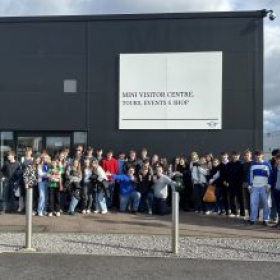Upper Sixth Business Studies Trip To Mini Production Plant
Published on isbi School News dated Tuesday 21st of March 2023
On March 10th 2023, a group of upper sixth bussiness studies students took a tour around the Mini production plant in Oxford. Plant Ocford is the heart of Mini. It's where all the parts are assembled and come together to make road-ready Mini models. It's the largest anf oldest of the three Mini Plants across the UK, including Plant Swindon where the body panels and some assembles are made, and Plant Hmas Hall, which produces petrol engines.
The students took a tour around the “body-in-white” facility where the MINI first takes shape. Body panels and sub-assemblies come into the body shop just in time and just in sequence from the Swindon Plant. The different body models can be produced in any sequence and Cell, Lean and Just-In-Time (JIT) techniques were all very much in evidence.
The next part of the tour took place in the “assembly” facility; this is the final stage in the MINI’s journey through Plant Oxford, where the car will be fully finished and sent to meet its new owner. Every MINI is given a barcode and transponder (a little red box on the bonnet), so each one can be immediately identified and tracked throughout the assembly process. This barcode also contains details of the customer’s individual specifications. Each MINI passes through a number of key fitting stages, including the cockpit, front end and electrical wiring harness. There is a stop at the automated robot glazing cell, before engine marriage, that uses state of the art camera visioning systems for quality checking. Then the wheels are fitted, and it’s on to fluid fill, petrol fill and door fitting before the car drives off the end of the production line.
Key Facts:
- 60% of cars produced are left hand drive.
- 25% of cars produced are electric. This % will have to increase closer to 2030 and therefore they will have to invest into new machinery and robotics.
- 1000 cars are produced every day a day – that’s one car every 67 seconds.
- There’s a mixture of cell production (for constructing body) and flow production (final assembly).
- Cars made are pre-ordered.
- There is mass customization (over a trillion different combinations can be made).
- The most expensive robot is called Rita which is valued at £100,000. This so-called co-bot works with humans.
- Over 200 robots are used, all costing over £30,000 and sourced from Sweden and Germany.
- Wiring for dashboards comes from Ukraine – when the war started they had to shut the plant for two weeks due to short supply but MINI is now working with suppliers in Ukraine again.
- The dashboards are produced off site, then assembled for 20 minutes before being fitted – JIT in evidence.
- Workers in final assembly are trained in 4 different areas and will change between areas on shift so it doesn’t get boring.
- The plant operates for 20 hours a day in two times 10-hour shifts.
- The most popular colour of MINI is white.
- MINI has a big focus on sustainability, including solar panels and rainwater used. Excess rubber from tyre production is used for roads.




